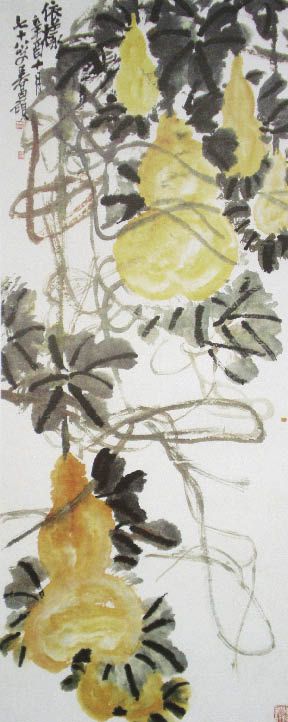|

When in his 30s, Wu Changshuo studied with Ren Bonian. His freehand bird-and-flower ink paintings stood out with their lavish colors and imposing compositions – a vigorous, vibrant breakaway from the flaccid and gloomy trend of the genre in the late Qing Dynasty.
Painting was long deemed an art for the elite of the society, but Wu Changshuo never intended to stay aloof from the general public. He catered to the aesthetic preference for bright colors by being the first in China to apply Western red pigment in his flower paintings, adding warmth to these traditionally black and white creations without impairing their inherent grace and simplicity.
Wu should be understood from his place in the transition of Chinese painting from the classic to the modern, and his clear influence on subsequent generations of painters such as Qi Baishi. Market prices for his works have been escalating in recent years, setting a record of RMB 16.5 million for 12 folding screens of flowers at the Guardian 2004 spring auction.
Liu Haisu
Liu Haisu (1896-1994) might be the most controversial artist in China. This son of a private banker in Changzhou, Jiangsu Province showed his maverick streak in childhood. He left home at 14 to study Western painting in Shanghai, and founded a fine arts institute with his classmates two years later. In 1918 he took his students on a painting tour to the West Lake in Hangzhou, unprecedented for art schools in the nation at the time, where classes were exclusively indoors. In 1919 his institute made more big news by enrolling girls, making it the first coed school in China.
The next year Liu Haisu jolted society again by using female life models, sparking roars from conservatives about the propriety of naked females in the school's studios. A Shanghai senator wrote an article in the local newspaper calling for the government to dole out punishment for the offence to general mores. The chair of the city's chamber of commerce also sent an open letter to the editor of a local newspaper reviling Liu as "lower than beasts." The local authority granted a secret warrant for his arrest, but Liu Haisu beat the wrap thanks to his friends' mediation. The episode only resulted in the avant-garde painter achieving instant notoriety in the nation.
In February 1929 Liu Haisu headed for Europe on a cultural exchange tour, during which he met prominent artists like Picasso and Matisse, and created over 200 works. On returning to China, he displayed these paintings in Shanghai and Nanjing, attracting more than 100,000 visitors. Liu made a second trip to Europe in 1933, lecturing in several universities and collecting more kudos on the continent.
Meanwhile, back home he was despised by many of his peers, including Xu Beihong, one of the greatest painters in modern Chinese history. Xu once wrote a letter to the government accusing him of treason during the Japanese occupation. In the 1990s some scholars claimed to have found evidence that many of Liu Haisu's paintings and writings made before the 1950s were actually the work of others. They argued that he didn't reach the artistic height we see today until the 20-year period beginning in 1957 when he was labeled a Rightist, since his reduced circumstances then prompted wholehearted commitment to his art.
| 
